Country guides

Things to do in Portugal
Sightseeing in Portugal consists of a warm climate, charming ports and friendly people. The sea has always been the country's first love, with the golden beaches and soaring cliffs of the Algarve attract millions of visitors every year. Vibrant, energetic tourist resorts in the south give way to the natural treasures of the Parque Natural de Ria Formosa.
The trademark seven hills of Portugal's historic capital city, Lisbon, stand over a colourful city. Visitors can wind their way through Lisbon aboard the famous Tram 28, and experience mournful Fado music in the Alfama district. Not to be missed is a day trip to the picturesque town of Sintra, nestled in the mountains north of Lisbon. Equally impressive is the walled town of Obidos, with its hilltop castle now turned into a luxury pousada (inn).
Not far away lie the mysterious megalithic monuments of the Cromeleque dos Almendres, situated just outside the lively university town of Evora. Porto, in the north, is an edgy city boasting a historic centre and great food and drink, as well as being a gateway to the famous Port-producing region of the Douro Valley. On the way north to Porto, visitors should stop to take in the atmosphere in Coimbra, former medieval capital of Portugal and home to the country's oldest university dating back to the 13th century.
Portugal's historic seafarers uncovered yet more delights in their travels west. The tiny island of Madeira is known as a 'floating garden', hiding a botanical wonderland and famous fortified wine behind its soaring ocean cliffs. Further west lies the Azores, dramatic island landscapes shaped by geological forces within the earth. Visitors can indulge in watersports, see whales and dolphins, hike to volcanic craters and explore the lush scenery.
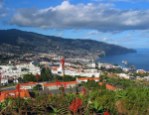
Funchal
Named for the abundant fennel trees in the area, Funchal has many beautiful parks and gardens. The Madeira Botanical Gardens offer stunning views, as well as more than 2,000 specie…
Funchal
Named for the abundant fennel trees in the area, Funchal has many beautiful parks and gardens. The Madeira Botanical Gardens offer stunning views, as well as more than 2,000 species of plant life, while the Jardins Do Palheiro and the Monte Palace Hotel Gardens are both worth a visit. This is also a stopping point for the Funchal Cable Car which goes up the mountain to Monte. There are also lovely old buildings and cultural sites, including the 15th-century Santa Clara Convent, the São Lourenço Palace, the Colegio Church and Sé Cathedral. The city is known for its excellent seafood, baked goods and local Madeira wine. There's also golf, swimming and paragliding, as well as boat trips and the unforgettable Levada Walks.
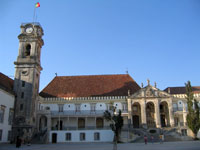
Coimbra
Coimbra was the birthplace of six Portugal's kings, with the country's first lying in a carved Gothic sarcophagus in the Monastery of Santa Cruz. There are several beautiful sites,…
Coimbra
Coimbra was the birthplace of six Portugal's kings, with the country's first lying in a carved Gothic sarcophagus in the Monastery of Santa Cruz. There are several beautiful sites, such as the Machado de Castro museum and Conimbriga, which is a fascinating Roman archaeological site. There are also a number of pretty parks and gardens, beautifully juxtaposed with the medieval wonderland of cobbled alleys, archways and stairs of the city. Coimbra is also one of Europe's oldest university towns, with the first building founded in the 12th century. Its students swarm the streets, bringing a lively atmosphere to the restaurants, museums, galleries, bookstores and boutiques.
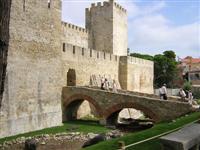
Castelo de São Jorge
The walls of Castelo de São Jorge sit atop a hill guarding the Tagus, dating from the Moorish occupation in the 10th century. But the site has been a fortress for centuries, possi…
Castelo de São Jorge
The walls of Castelo de São Jorge sit atop a hill guarding the Tagus, dating from the Moorish occupation in the 10th century. But the site has been a fortress for centuries, possibly from 500 AD. The castle is regarded as the cradle of Lisbon and today provides a panoramic view of the River Tagus and the Alfama medieval district below. Visitors can walk the esplanades and climb the ramparts while a multimedia show is available during the day which brings alive the history of Lisbon. The castle grounds are planted with olive, pine and cork trees and provide a pleasant spot to relax.
Website www.castelodesaojorge.pt
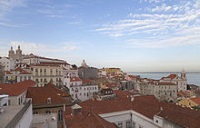
Alfama
The oldest part of Lisbon, the Alfama quarter sprawls down the hillside from below the Castelo de São Jorge. It retains much of the traditional colour and atmosphere from the days…
Alfama
The oldest part of Lisbon, the Alfama quarter sprawls down the hillside from below the Castelo de São Jorge. It retains much of the traditional colour and atmosphere from the days when it was the ancient seat of the Saracens. Along the narrow cobblestone alleyways are taverns and street markets, interspersed with close-packed houses still occupied by stevedores, fishmongers and sailors. Lisbon's renowned flea market, the Feira da Ladra, is held in the Campo de Santa Clara at the edge of the Alfama, every Tuesday and Saturday. The Alfama is also full of historic buildings and churches, which are well-worth exploring.
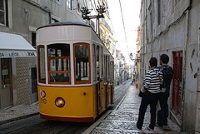
Bairro Alto
The Bairro Alto district is a historic enclave dating back to 1513, reached via the Santa Justa Elevator from the lower city. The colourful district resounds to the calls of vendor…
Bairro Alto
The Bairro Alto district is a historic enclave dating back to 1513, reached via the Santa Justa Elevator from the lower city. The colourful district resounds to the calls of vendors and fishmongers while the windows and balconies are festooned with laundry and bird cages. At night, the area comes alive with some of the finest fado cafes in the city along streets lit by Victorian lanterns, with fado being the famous brand of music and dance brought to Portugal by African slaves in the 19th century. There is no better place in Portugal to experience this musical genre than in the Bairro Alto of Lisbon.

Monument to the Discoveries
One of the most famous sights in Lisbon is the imposing Padrão dos Descobrimentos, situated on the riverbank along Avenida de Brasilia in the district of Belém. Designed to comme…
Monument to the Discoveries
One of the most famous sights in Lisbon is the imposing Padrão dos Descobrimentos, situated on the riverbank along Avenida de Brasilia in the district of Belém. Designed to commemorate the Portuguese Age of Discovery, Belém, where the Tagus meets the sea, is the point from which the maritime explorers of yore set forth in their sailing ships to discover the world. The monument was unveiled in 1960 on the 500th anniversary of the death of Prince Henry the Navigator in 1460. The massive monument takes the form of a caravel with Prince Henry at the prow, backed by images of renowned mariners, royal patrons and others who participated in the Golden Age of Discovery.
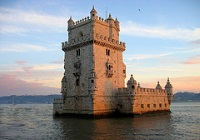
Tower of Belém
Belém Tower, also known as the Tower of Saint Vincent, is a fortified tower located in the civil parish of Santa Maria de Belem. The tower was built in the 16th century to serve a…
Tower of Belém
Belém Tower, also known as the Tower of Saint Vincent, is a fortified tower located in the civil parish of Santa Maria de Belem. The tower was built in the 16th century to serve as a fortress in the middle of the River Tagus. A UNESCO World Heritage Site along with the nearby Jeronimos Monastery, the famous Belém Tower is one of Lisbon's most photographed landmarks. The outer walls are adorned with beautiful openwork balconies and a stone-carved rope, along with Moorish watchtowers and battlements shaped like shields. Visitors to the site should make sure to get a guided tour to learn the rich history of the beautiful structure.
Website www.torrebelem.pt
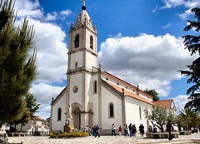
Fatima
In 1917, the Virgin Mary allegedly appeared above an oak tree and spoke to three peasant children in the valley of Cova da Iria, 79 miles (127km) north of Lisbon. The children clai…
Fatima
In 1917, the Virgin Mary allegedly appeared above an oak tree and spoke to three peasant children in the valley of Cova da Iria, 79 miles (127km) north of Lisbon. The children claimed to have seen the apparition on five different occasions, and the spot has now become one of the great pilgrimage shrines of the world, known as Fatima. Between May and October, the 13th day of every month is pilgrimage day, when hundreds of the faithful gather in a square twice the size of St Peter's in Rome before the Chapel of the Apparitions. The original oak tree is gone, but has been replaced by a simple white column inside a basilica, which is flanked by statues of the saints.
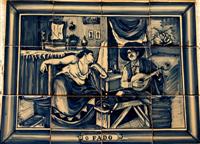
Frederico de Freitas Museum
The Frederico de Freitas Museum in Funchal houses a vast array of decorative pieces. Turkish, Moorish and North African tiles, as well as about 2,000 mugs, trophies and vases are o…
Frederico de Freitas Museum
The Frederico de Freitas Museum in Funchal houses a vast array of decorative pieces. Turkish, Moorish and North African tiles, as well as about 2,000 mugs, trophies and vases are on display, along with Madeiran artefacts, porcelain works, religious sculptures, ancient sacred paintings and Chinese and North African metal and woodwork. When Frederico de Freitas died, he left his collection to the Autonomous Region, during which time the building was expropriated by the Regional Government. It then started rebuilding and restoration works on the house for the purpose of opening it to the public as a museum.
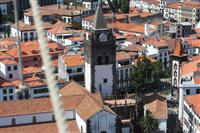
Funchal Cathedral
In the heart of the historic section of Funchal stands the Sé do Funchal, the most impressive of Madeira's religious edifices. The simple rough white stucco and brownish basalt of…
Funchal Cathedral
In the heart of the historic section of Funchal stands the Sé do Funchal, the most impressive of Madeira's religious edifices. The simple rough white stucco and brownish basalt of the cathedral houses the Gothic portal. The ceiling is Moorish carved cedar inlaid with ivory and behind the Baroque altar are paintings by Flemish and Portuguese artists. The late fifteenth-century cathedral is one of the few structures that survived intact since Madeira's early period of colonisation. As the centerpiece of the structure, the cathedral contains a silver processional cross, donated by King Manuel I of Portugal, considered one of the masterpieces of precious metalwork of Portugal's Manueline style.
Website www.sefunchal.com
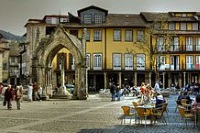
Guimarães
The historic town of Guimarães is regarded as the birthplace of Portugal. Here, in 1128, Afonso Henriques became the first king of the country. Guimarães has many medieval buildi…
Guimarães
The historic town of Guimarães is regarded as the birthplace of Portugal. Here, in 1128, Afonso Henriques became the first king of the country. Guimarães has many medieval buildings and fortifications, and has been declared a UNESCO World Heritage Site. One of the main attractions is the tiny Romanesque church where Afonso was allegedly baptised, and the imposing Palace of the first Duke of Braganza. There are numerous other Gothic, Romanesque and Baroque delights to discover in walking around the town. There are also two excellent museums: the Museu Alberto Sampaio contains religious art and relics and is housed in a monastery; while the Museu Arquelogico Martins Sarmento displays the finds from a nearby Celtic hill settlement.
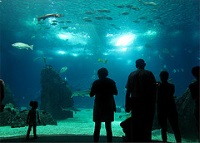
Lisbon Oceanarium
Marketed as the second best aquarium in the world, the world-class Lisbon Oceanarium is the most impressive achievement of EXPO '98, which used to be an abandoned waterfront. The c…
Lisbon Oceanarium
Marketed as the second best aquarium in the world, the world-class Lisbon Oceanarium is the most impressive achievement of EXPO '98, which used to be an abandoned waterfront. The centrepiece of the stone and glass building is the 1,3 million gallon (5 million litre) holding tank. The Oceanarium consists of four distinct ecosystems that replicate the Atlantic, Pacific, Indian and Antarctic oceans, each featuring the birds, amphibians and reptiles associated with those waters. Otters splash and dive in the warmer Pacific waters, while penguins shuffle around in their tuxedos in the Antarctic section.
Website www.oceanario.pt
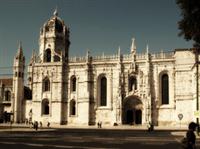
Jerónimos Monastery
One of Portugal's most iconic tourist sights, the Jerónimos Monastery is an absolute must-see attraction for visitors to Lisbon. A stellar example of Manueline, also known as Port…
Jerónimos Monastery
One of Portugal's most iconic tourist sights, the Jerónimos Monastery is an absolute must-see attraction for visitors to Lisbon. A stellar example of Manueline, also known as Portuguese late-Gothic architecture, the Jerónimos Monastery is a UNESCO World Heritage Site, earning its place in the registry on the basis of its architectural splendour that 'exemplifies Portuguese art at its very best'. The Jerónimos Monastery is a beautiful building, resplendent in a gleaming ivory hue with sharp spires, intricate sculptural details and maritime motifs. The cloisters are particularly magnificent, with each column individually carved with coiled rope, sea monsters, coral and other designs that bespeak an era of nautical adventure.
Website www.mosteirojeronimos.pt/en


